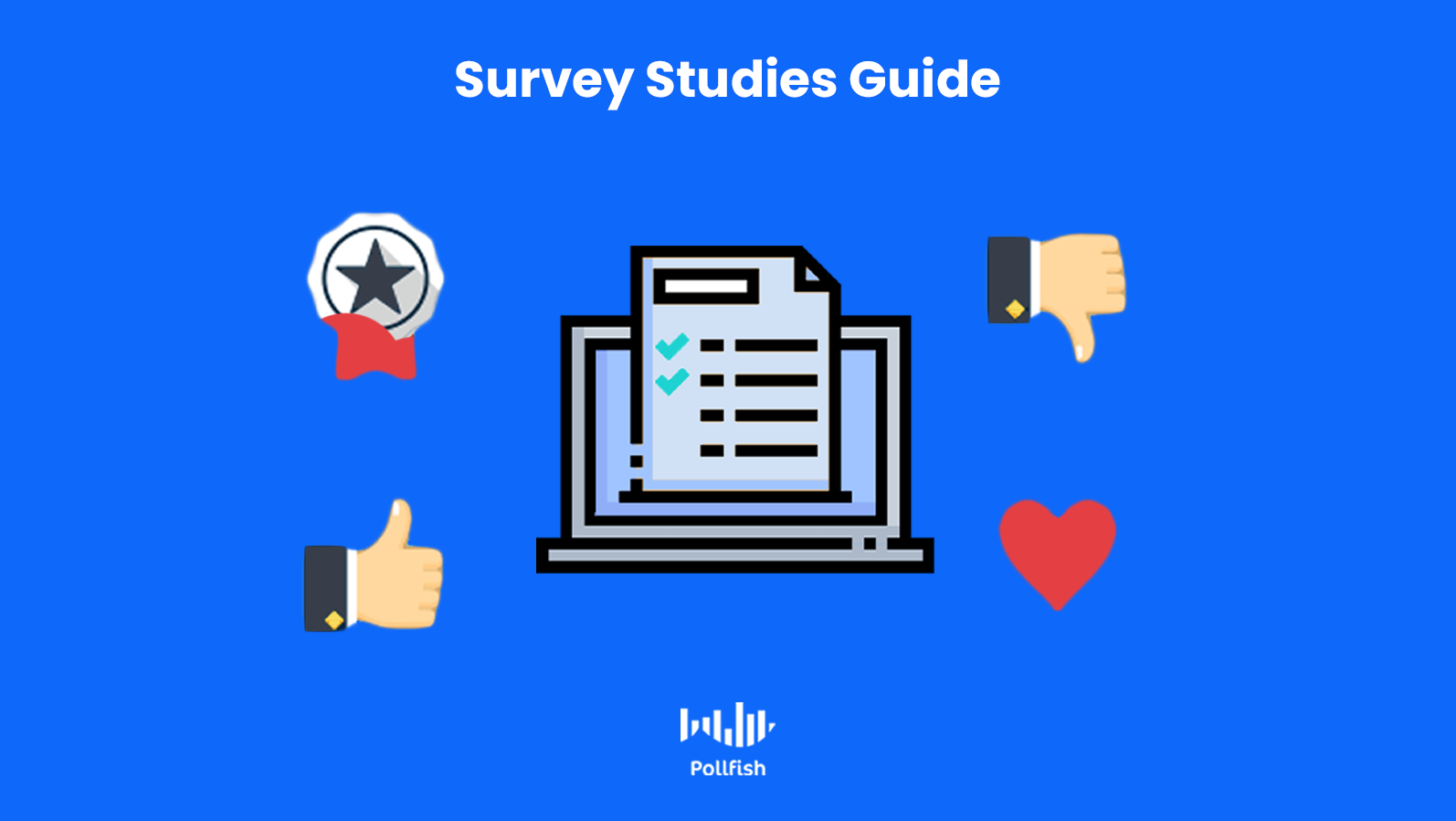How to Build Effective Survey Studies for Valuable Market Research
Survey research is an invaluable approach to primary research for any market research campaign. Effective survey studies allow you to observe virtually any topic as it relates to your target market, including a specific segment of your target market.
But with so many types of survey research campaigns and survey studies, it can be challenging to decide on how to pursue and form a survey study. After all, the goal with any data collection campaign is to extract data that is as accurate and reliable for your research needs.
This article expounds on how to build effective surveys from the ground up so you can proceed with your survey research with knowledge and ease of mind.
Finding the Macro-Application for Survey Studies

Every survey needs a purpose. Say you have a burning curiosity about your customer base. When tackling survey research, connect this curiosity to a more general-purpose for your business or institution (if you are a market researcher outside the business sphere).
Surveys can be applied to a vast number of macro-applications, i.e., the applications dealing with some category in the business or research sectors. First, find the most important topics (or said curiosities) that you would like to see your survey address. Then, categorize them in one of the following macro-applications:
- General Marketing: Marketing involves all the activities needed to promote a business. Marketing market research exists to help businesses gauge their campaign efficacy and better understand their customers. If you choose this application, consider how you can gain insights more deeply by choosing a subdiscipline within marketing.
- Advertising: Deploying sponsored messages to grow demand and elicit purchases, advertising is used to influence customer behavior. This involves prompting existing customers to make further purchases or acquire new customers. Surveys can be used to see which advertising messages are the most resonant and which ads spawn the most interest. Researchers can ask questions centered on comparing full ads, or parts of an ad such as the imagery, a video snippet or the copy.
- Branding: This discipline involves creating a reputation, an image and a set of associations around a brand. Branding helps brands differentiate themselves from one another, along with establishing a style that a company is easily remembered by. Businesses can tie their surveys to branding by creating surveys to test new logos, slogans, a unique value proposition, content ideas (for example, if a company that sells electronics seeks to attach lifestyle content to its branding) and more.
- Market Segmentation: This macro-application refers to studying customers closely by dividing a target market into smaller segments. After all, a target market includes all the customers most likely to buy from a particular business, but it is not solely defined by one group. At their core, business surveys are designed to understand customers to a T. With this said, researchers can form personal questions about their target market’s habits, lifestyles, preferences and more to distill them into several segments. From there, marketers can adopt different marketing campaigns for each segment.
- PR: Public Relations, or PR, as it is commonly referred to, aims to control the distribution and spread of information about a company (or individual) and the public. Its goal is to control the narrative of a business or organization to gain positive public perception. Surveys can help on this front in that researchers can design questions on how well respondents know a business and their general thoughts on its operations, products, experiences, performance, etc. Researchers can also test out press release ideas and pitches through these surveys.
Turning to Secondary Research
After filtering your curiosities and questions into a specific macro-application, you need to find all the available information surrounding this application as it relates to your survey subject. This means, before setting up your survey, researchers ought to turn to secondary research.
This is because you wouldn’t want to forego key data already conducted and made available. If you do, you’ll ask redundant questions, wasting both time, money and your survey on matters you could have found from secondary sources.
There are various secondary resources available online. These include webzines, trade publications, news sites and statistics websites. Additionally, research departments in universities launch their results online, which is especially if they cover your sector. You will need to visit these but the ones that study your particular industry and niche. MarketResearch.com is an efficient secondary source, as it covers timely reports across a gamut of industries.
Scrutinizing your competitors’ digital properties is also a useful way to understand your target market, as it is shared (otherwise they wouldn’t be your competitors). B2B businesses in particular often publish reports on their industry, which often covers customer insights.
Researchers should collate and carefully organize the key and auxiliary findings they’ve gathered. To do this, creating a document to store all the information is necessary. The insights in the document will help in putting together surveys.
Preparing Preliminary Questions
After you’ve chosen a macro-application and gathered secondary information on it in relation to your industry and target market, you can advance to the preliminary question stage.
In this stage of building effective surveys, you should revisit some of the original curiosities and questions you wished to inquire of your target market. The most practical way to move forward is to cross-reference these original questions with the document of secondary research information.
Here is what to consider when doing so:
- Does any of the information you’ve found from conducting secondary research answer any of your original inquiries? If so, you won’t need to use the same questions in your surveys, unless you would like to extend the information from those questions. Perhaps the information you gathered answers only part of your question, or only about one segment of your target market.
- In these cases, it is apt to use the original question in your survey planning as a preliminary question. You can also evolve questions to make them veer in a slightly different, but not altogether different direction.
- Continue cross-referencing until you’ve gathered at least 10 questions you would like to see answered by your target market.
- Do any of them intertwine or focus on a similar topic? If so, consider grouping questions together, to determine if they’ll require being used in one or multiple surveys.
- When you’ve put together your preliminary questions, it’s time to contemplate the kind of study you’ll need to employ.
Choosing a Methodical Form of Survey Studies
Survey research entails much more than simply launching surveys through an online survey provider and waiting for results to pile in. Rather, it requires a more methodical approach, one with a particular timeframe and pipeline.
There are several forms of survey studies that are time-dependent. The following explains them:
- Retrospective Studies: Also called historical research, a retrospective study gathers data on occurrences that have already happened. As such, respondents discuss their past opinions, happenings and other memories in these surveys.
- Cross-Sectional Studies: A study in which research that gathers research about a targeted population at one fixed point in time. This type of survey research method is known as being a snapshot of a studied population.
- Longitudinal Studies: A study that gathers data on the same set of respondents over a period of time. This kind of research grants researchers the ability to closely examine the trajectories of their subjects over time (weeks to decades).
- Prospective Studies: A longitudinal cohort survey study that gathers data from similar respondents with a few dissimilar factors to determine how those factors affect a particular outcome.
Identifying the Correct Survey Research Method
After choosing the most suitable time-based survey study method, you need to identify another research method to carry out your survey studies. This kind of method deals primarily with the observational style and type of analysis you’ll need to conduct from your survey studies.
There are many different forms of survey research in this regard. The following lists the chief three such methods.
- Descriptive Research: This form of survey research is planned in advance and designed to extract data that can then be used for making statistical inferences on a target market. Aa such, it is considered conclusive and requires conducting quantitative survey studies.

- Exploratory Research: This kind of survey study is critical for the marketing and strategy aspects of a business. As opposed to gathering quantitative research, it focuses on discovering new ideas and insights, especially those pertaining to a target market and industry demands. In online surveys, exploratory research is often conducted via open-ended questions. This research method is qualitative, seeking to further grow a business and define company goals.
- Causal Research: Also quantitative and planned beforehand like descriptive research, this form is therefore deemed conclusive. Casual research seeks to discover the cause and effect between variables. It isn’t a form of observational research, as descriptive research is, however, as it sets to determine causal relationships via experimenting.
Opting for the Proper Survey Type for Your Survey Studies
When you have a steady strategy of the research methods your survey studies will apply, it’s time to adopt the proper survey type(s) for your survey study needs. Various survey types can be applied to different survey research methods.
In this regard, you can opt for survey types with your chosen research methods in a mix and match fashion. This is because different survey types are flexible; they have the potential to satisfy a bevy of research methods, including both time-based and analysis-based methods. The deciding factor for the survey types you implement is dependent on the subject of your study.
The following lists the different types of surveys to use in your studies. Several have their own sub-types of surveys.
- Customer Satisfaction Surveys:
- Gauge customer satisfaction with products, services, experiences & more.
- Includes the following subtypes: Net Promoter Score (NPS) surveys, Customer Satisfaction Score (CSAT) surveys, Customer Effort Score (CES), Visual RAtings surveys and custom surveys.
- Event Evaluation Surveys:
- Evaluate the experience and performance of participants in an event within the eyes of attendees.
- Can exist in print form (distributed at the event) or in online surveys.
- Brand Awareness Surveys:
- Measure how well your target market knows about your brand, along with providing opinions on its key features (logos, reputation, efficiency,etc.)
- Ideal for branding campaigns and before employing survey studies on advertising.
- Lead Generation Surveys:
- Purposed to gain contact information from your target market and reveal the types of individuals who make up your target market.
- Great for market segmentation and early research (before other survey types).
- Job Satisfaction Surveys:
- Used to understand how members of your target market feel about their jobs, a critical force in their identities and whether they can afford your product/service.
- Helps you learn which respondents are more satisfied with work/ income, thereby revealing which segment is more likely to spend.
- Employee Feedback Surveys:
- Used in businesses for internal purposes surrounding their own employees.
- Helps understand current pain points, successful and poor management styles, best HR incentives and how to improve processes and communication.
- Consumer Loyalty Surveys:
- Calculates how many and if members of your target market are loyal to your brand and your competitors.
- Helps brands reap customer loyalty.

Crafting the Questions for Survey Studies
Once you’ve chosen the most fitting survey types to use in your studies, you can finally move on to the survey itself. A sturdy online survey platform will allow you to get creative, granular and analytical with your survey production.
First, create a specific list of demographics and behavioral characteristics you will need to examine in your survey studies. Preset these requirements in the screening section of your survey tool. You should set quotas to assure you’re obtaining the appropriate respondents in your survey.
Next, consolidate your preliminary questions with the new ones you’ve come up with while identifying the correct research methods. These oftentimes influence the kinds of questions you’ll need to ask. This also requires organization, as certain questions will belong on different surveys.
If you’re struggling to form relevant and useful questions, read our guide on writing survey questions. When you’ve come up with questions, considering adding layers to your survey. For example, a particular answer that one respondent answers with may require a different follow-up question than that which another respondent answers with.
Sometimes, this requires creating different question paths for different types of answers. You can achieve this by applying advanced skip logic into your survey. Your online survey tool of choice should allow you to add media files (images, GIFs, video snippets) to make your survey more engaging.
Remember to keep your surveys so as to avoid survey attrition. Now that you’ve come up with the questionnaire questions, review your entire survey. Make sure you’re asking the questions that will help flesh out your survey studies.
Once you do that, you’re ready to launch your survey.
Other Considerations for Survey Studies
There are several things you need to consider for your survey studies, most of which are dependent on the online survey platform you use. These involve ease of use, respondent capacity, publisher networks (where the surveys will be deployed) and many more user experience (UX) capabilities.
For example, in the aforementioned survey types section, there are dozens of surveys you can form for both research and business purposes. It is key to use a platform that can provide structures and elements for all, or at least for the kinds you need.
As for ease of use, assess the difficulty in using an online survey tool. A strong survey platform allows you to make a survey in three easy steps. When you thoroughly vet a survey platform, you can objectively decide which is best for your survey studies.
Frequently asked questions
What is survey research?
Survey research is the process of performing research through the use of surveys. After the survey data is collected from respondents, it is analyzed in order to draw conclusions about the topic at hand.
What are some of the macro applications of surveys?
Surveys can be used to understand many broad aspects of business or research including general marketing, advertising, branding, market segmentation, and public relations.
What is secondary research?
Secondary research is the process of gathering information that has already been conducted and is made available for collecting and studying.
What is descriptive survey research?
Descriptive research is conducted to explain the characteristics of a sampling pool or a study of an issue. It is a form of survey research that is performed by conducting quantitative surveys in order to extract data that can be used to make statistical inferences.
What is exploratory survey research?
Exploratory research is the earliest form of research conducted around a subject. It is used in order to identify new ideas and insights, particularly about a problem not clearly defined for further studies, such as descriptive research. It is done by conducting qualitative studies in order to gain new information about the subject.
Pollfish Marketing Team
Ready to Try Pollfish?
Create your survey with AI, target high-quality respondents starting at $0.95 per complete, and start getting results in just minutes in real-time. From running a simple product concept survey to managing a constant stream of trackers for dozens of clients in dozens of countries, we’ve got you.



